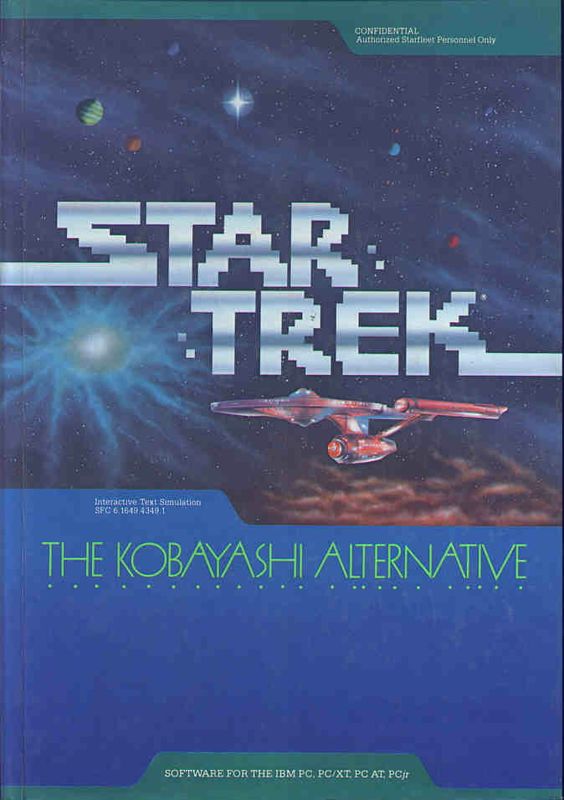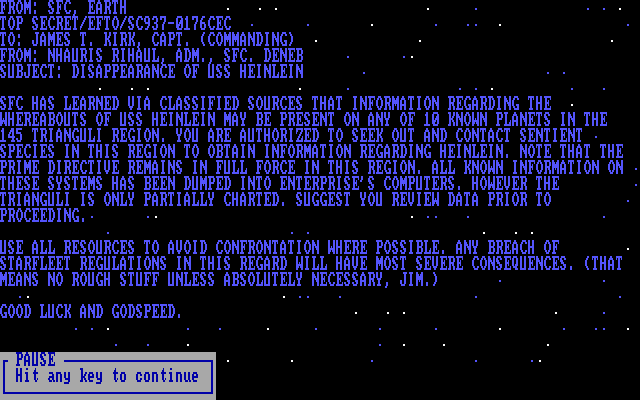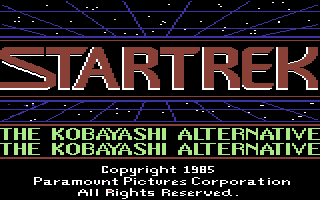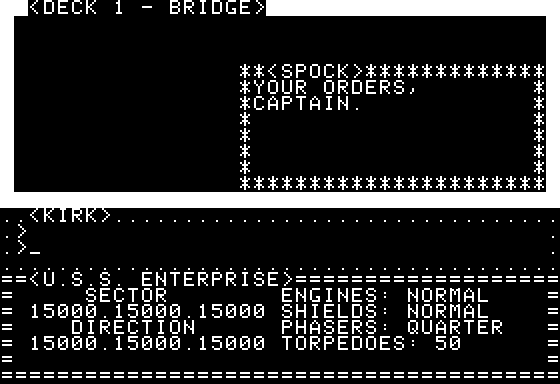Retro Replay Review
Gameplay
Star Trek: The Kobayashi Alternative delivers a rich interactive fiction experience that combines classic command-line input with modern dialog boxes. You’ll type familiar “go north” or “examine console” commands, but you’ll also see pop-up dialog trees when engaging with Kirk’s crew. This dual-input system feels intuitive—seasoned IF veterans will appreciate the nod to Infocom titles, while new players will enjoy the guided prompts that keep the narrative flowing.
(HEY YOU!! We hope you enjoy! We try not to run ads. So basically, this is a very expensive hobby running this site. Please consider joining us for updates, forums, and more. Network w/ us to make some cash or friends while retro gaming, and you can win some free retro games for posting. Okay, carry on 👍)
As Captain Kirk, your mission is to navigate the Kobayashi Alternative Command Performance Evaluation. You plot courses through star systems, debate course-of-action options with Spock and McCoy, and dispatch away teams to mysterious planets. Each choice you make shapes the outcome of the test and earns you a grade in command decision-making. Puzzles range from deciphering alien code sequences to managing limited transporter power, offering a balanced blend of logic challenges and narrative-driven decisions.
The game not only tasks you with high-stakes problem solving, but also invites you to explore the legendary decks of the USS Enterprise. From the bridge’s sleek control panels to the engineering hull’s maintenance shafts, every deck yields environmental puzzles or hidden logs. Exploration is thoroughly rewarded: side corridors hide scientific anomalies, and the ship’s computer databanks store logs that enrich your understanding of Starfleet protocols.
Replayability is high. Different dialog choices unlock new crew interactions, and alternative puzzle solutions lead to divergent mission outcomes. Even optional subplots—like mediating a dispute between science and security officers—add depth, making multiple playthroughs feel fresh. Whether you prefer cerebral problem solving or role-playing as the boldest captain in the quadrant, the gameplay hooks you from the first prompt to the final status report.
Graphics
Graphically, The Kobayashi Alternative adheres to a minimalist, text-driven aesthetic. There are no high-resolution cutscenes or 3D models; instead, the game presents colored text blocks, ASCII-style star maps, and stylized dialog windows. While this may disappoint action-oriented gamers, it perfectly suits those who prioritize narrative immersion over flashy visuals.
Text formatting plays a crucial role in guiding the eye: command prompts appear in bold white, alien dialogue in pale green, and system messages in amber. This deliberate color coding keeps multi-threaded conversations clear, even when you’re juggling simultaneous crises on the bridge. Occasional ASCII schematics—such as a top-down view of the engineering deck—serve as simple but effective visual aids for spatial puzzles.
Loading screens include richly written vignettes that set the scene for your next mission, accompanied by subtle ambient background music and sound effects. The gentle hum of the warp core, the beep of the transport console, and the occasional Klingon battle roar—these audio cues enhance immersion without overwhelming the text focus.
Though fans of graphic-heavy titles might see the presentation as barebones, the game’s interface strikes a careful balance: it’s clean, responsive, and designed to put your imagination in the captain’s chair. The absence of elaborate graphics is not a drawback but a deliberate design choice that complements the depth of the writing and the classic IF tradition.
Story
The Kobayashi Alternative puts you right at the heart of a Starfleet evaluation scenario: a high-pressure simulation designed to test your command capabilities. Through branching narrative paths, you’ll confront dilemmas that range from diplomatic first contact to life-and-death engineering catastrophes. The stakes feel genuine—your decisions carry weight, and failure can lead to simulations of ship evacuation or even crew casualties.
Familiar faces abound. Spock’s logical counsel contrasts sharply with McCoy’s emotional perspective, and your interactions with them can influence the outcome of critical discussions. New characters—like a Vulcan ensign with a penchant for puzzles or a security chief exploring his own moral code—enrich the crew tapestry. The writing deftly balances homage to the original series with fresh flourishes that keep the narrative from feeling derivative.
Planetary sequences showcase the writers’ imaginative flair: whether you’re stranded in a geyser-ridden valley or navigating a labyrinthine alien archive, descriptive prose paints vivid mental images. Environmental details are woven seamlessly into puzzle clues, ensuring that the story and gameplay drive each other forward.
Multiple endings reflect the culmination of your command performance. Some paths reward bold, risk-taking captains, while others favor cautious problem solvers. In all cases, the narrative feedback—complete with post-simulation debriefs from Admiral Kirk—provides satisfying closure and entices you to replay in search of alternative outcomes.
Overall Experience
Star Trek: The Kobayashi Alternative is a standout interactive fiction title that will appeal to both hardcore Trek enthusiasts and fans of narrative-driven puzzles. Its hybrid input system makes the experience accessible, and the meticulously crafted scenarios demonstrate a deep respect for the source material. If you’ve ever wanted to know how Captain Kirk thinks under pressure, this game puts you in the captain’s chair like few others.
The blend of text-only presentation and evocative writing transforms your screen into the bridge of the Enterprise. Emergencies unfold in real time, crew personalities shine through dialog trees, and every mission feels consequential. Even without polygonal starships or flashy effects, the game delivers “you are there” immersion through pure storytelling prowess.
While players seeking action-oriented visuals might be better served elsewhere, anyone who values replayability, branching narratives, and classic IF mechanics will find The Kobayashi Alternative immensely rewarding. It’s a must-play for Star Trek lore fans and an excellent introduction to interactive fiction for newcomers.
Ultimately, this game proves that the final frontier often lies within the player’s imagination. By the time the simulation ends, you’ll have charted dozens of star systems, negotiated with alien species, and tested your command mettle under every conceivable scenario. For those ready to boldly go where few text adventures have gone before, The Kobayashi Alternative is waiting.
 Retro Replay Retro Replay gaming reviews, news, emulation, geek stuff and more!
Retro Replay Retro Replay gaming reviews, news, emulation, geek stuff and more!









Reviews
There are no reviews yet.